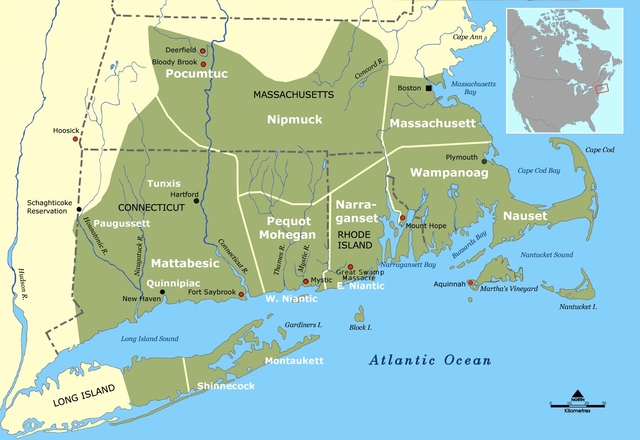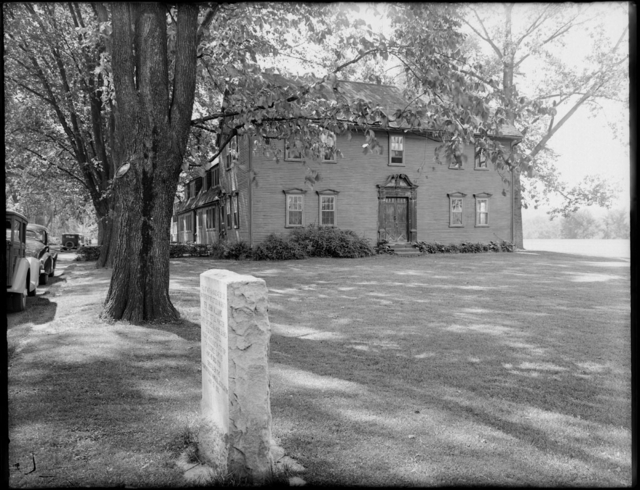Psalms and Silence: The Soundtrack of John Williams’s Captivity
It is December 5, 1706, and John Williams, a minister of the frontier town of Deerfield, has not been among so many godly Christians in nearly two years. Cotton Mather’s usual 1,500-member congregation at the Society of the Second Church in Boston is swollen by many on-lookers, and Williams is the object of their curiosity. A month before, the people of New England had greeted his return to Boston after nearly two years of captivity in Catholic Canada as a triumph of the Christian faith. Neither the savagery of his Indian captors nor the idolatry of the Catholics he met to the north broke Williams’s resolve. His survival and safe return from the “howling wilderness” made him the closest thing colonial New England had to a Christian celebrity.
It is Williams’s honor to deliver the sermon, or “lecture,” to this righteous congregation. Whatever trauma Williams suffered, it did not impair his ability to craft a powerful lecture, and he is confident that his stern message about God’s judgment on those who were taken captive and those who remained comfortably behind will resonate with the congregants. First, though, he sits on the church bench, surrounded by the truly faithful—the Saints whose experience of their own sin and redemption has been hard won through great personal questioning, and thus is sincere. It is a breathtaking experience, being among Puritan brethren after so many months exposed to heathens and Catholics, months in which he was denied any chance to fulfill his duty to his congregation and to the Lord, prevented from preaching, praying, and singing psalms. Worse still, Williams had been forced to attend Catholic Mass, memories of which will haunt him for years to come.
Williams’s reverie is broken as the congregation rises to sing a psalm. The sacred song stirs him, summoning memories of his captivity.

A map of early Puritan settlements and Algonquian groups in the seventeenth century, with Deerfield visible at upper left. Wikimedia Commons
Williams took up his pen to write a narrative of his sojourn when he returned to Deerfield late in the winter of 1706-1707. Just before dawn on February 29, 1704, he wrote, “the Enemy came in like a Flood upon us.” He awoke suddenly as they managed to “break open Doors, and Windows, with Axes and Hatchets,” stormed into the room where Williams rested with his wife, “with Painted Faces and hideous Acclamations.” Struggling out of bed, reaching for a weapon, fearing for his family, Williams could not identify the invaders. To him they were simply “the Enemy.”
The raiders were in fact a combined force of Europeans and Indians, consisting of more than 250 Abenaki, French, Huron, Iroquois, Mohawk, and Pennacooks fighters. The attack had several motives: a colonial proxy battle in the War of Spanish Succession, it was also an act of retribution for English encroachment on Abenakis and Pennacooks territory, a ploy to gain high-value captives (namely Williams) who could be exchanged for French prisoners in Boston, and a strategy for native population renewal. These reasons would be sorted out later. The immediate effect of the attack was deadly: fifty killed, over one hundred taken captive. Roughly half of Deerfield’s residents were killed or captured—among them Williams, his wife Eunice, and their three sons and two daughters. Two of the children died in the attack, and Eunice succumbed on the second day of captivity. The survivors traveled north, wading through thick snow and fording icy rivers toward New France.
On the sixth day of their journey, the minister was allowed to lead his reduced congregation in worship. “On the Sabbath Day we rested, and I was permitted to Pray and Preach to the Captives,” Williams recalled. But the Indian captors interrupted the impromptu worship service. “Sing us one of Zion’s songs,” they demanded. The captives complied, timidly singing a sacred psalm. But as Williams recounted, the captors “were ready some of them to upbraid us, because our singing was not so loud as theirs.”
The ridicule stung, but it also indicated the deep religious and cultural chasm gaping between the captives and their captors. To many of the Indians, this quiet singing revealed a more general weakness of character and identity. The captives’ inability to sing their own songs was disgraceful and deserving of mockery, according to native traditions. Yet some of the Indian captors were Catholic converts, and the Frenchmen who had participated in the raid were also Catholic. As Catholics, they couldn’t help but notice that Puritan psalmody was a far cry from the sacred music of the Catholic Church, which was complex, polyphonic, and in Latin. For the Puritans, sacred music (“Zion’s songs”) meant psalmody, or metricized versions of the verses from the Book of Psalms set to simple melodies and sung in unison. Although austere and plain, psalmody was meaningful for Puritans, a fundamental way for the faithful to express their devotion to God and their integrity as a community. As a deeply affective practice that allowed the individual to express his or her personal piety, singing psalms also bound the congregation together.
Puritan singing was rarely beautiful. Indeed, by the early eighteenth century, congregational psalmody was cacophonous. For years, declining music literacy and isolation had led to the deterioration of musical ability in New England congregations. Individuals freely embellished the tunes. Congregations were undisciplined, not singing together, and singing more and more slowly. Usually the congregation waded through each psalm tune with each individual improvising his or her own variation.
Since psalm singing was turgid and disorganized in the best of circumstances, when the frightened, freezing, and exhausted Deerfield captives sang, the performance was especially sorry. The day before, four women had been killed because they couldn’t maintain the brutal pace of the march, and the survivors’ fear was evident in their quavering song. Their voices sounded thin and weak, buffeted by wind, losing their resonance amid the ice-crusted snow and leafless winter trees. Singing reminded the congregation of how vulnerable they were, for it highlighted the absence of protective wooden church walls to contain and reverberate the music. Singing psalms was supposed to provide emotional and spiritual sustenance, but instead it underscored the tenuousness of the captives’ existence.
Can we know what was sung? In his captivity narrative Williams claimed that he preached from Lam. I. 18, a verse that addresses the immediate source of and reason for their plight: The Lord is righteous, for I have rebelled against his commandment: hear, I pray you, all people, and behold my Sorrow: my virgins and my young men are gone into captivity. What psalm would match these repentant words? Perhaps Psalm 69, known for its evocation of the inner state of the sorrowful and tempted singer lost in deep waters, threatened by enemies, awaiting rescue by God. The tune to which Psalm 69 was set in the 1698 Bay Psalm Book—the first psalter published in North America to include printed music—was thought to be particularly consolatory. This tune is called “Litchfield.”
“Litchfield”
It is in a delicately modal minor key. The melody is made up of a series of intervals, broken thirds and fourths in a disjunct motion that enhance the searching, yearning mood of the minor mode. Even as the tune comes to rest at the beginning and end of every phrase on the long note, the sense of motion and even unease is always present.
It is possible to imagine Williams and his fellow-captives warbling their way through this deeply expressive psalm as their unsympathetic audience listened. They would have been singing in their peculiar manner, however: perhaps more than twice as slow as this recording, taking two or three breaths with each note, diverging from each others’ tempos, improvising on the melody. To the listening captors, this weak and discordant performance might have seemed to knell the captives’ imminent disbanding as a congregation. The ruptures were dizzying: first seized from their homes, then separated from each other, and potentially cleaved from their faith by a future conversion to Catholicism.
Humiliating and destabilizing as the captive psalmody performance was, at least it was a chance for congregational worship. Four days later, on March 9, Williams was allowed to pray and sing a psalm with his flock one final time. After that, he and the captives were divided into smaller groups for the remainder of the journey. Separated from his remaining children, Williams worried and suffered. But he found some spiritual relief on the trail: “My Master gave me a piece of a Bible,” Williams wrote, and “never disturbed me in Reading the Scriptures, or in Praying to God.” For nearly two months during his journey from New England to New France, Williams found solace in psalms and Bible verses, though he no longer had a congregation to sing with. (Williams eventually found out that this tolerant treatment was not unique: “Many of my Neighbours also, found that Mercy in their Journey, to have Bibles, Psalm-books, Catechisms, and Good Books, put into their hands, with liberty to use them.”)

An anonymous portrait of Jean-Baptiste Hertel de Rouville, the commander of the Deerfield Raid. Wikimedia Commons
The situation changed dramatically once Williams arrived in Canada, where he found himself under the control of an “Enemy” far more troubling than the supposedly savage Indians: Catholic French colonists and their Jesuit priests. Williams and his fellow captives “were forbidden Praying one with another, or joining together in the Service of God.” He learned from his fellow captives that “their Bibles were demanded by the French Priests, and never re-delivered to them, to their great grief and sorrow.” The journey north may have been exhausting and terrifying, with the threat of death ever present, but that danger was simply one of mortality. Being delivered into the hands of Catholic priests threatened their souls.
What followed was a series of clashes with the Jesuit missionaries who led religious life in settlements along the St. Lawrence River. Williams noticed the comparative successes of the Catholics in converting Indians to Christianity. Whereas in New England attempts to convert the native population had proceeded haltingly for six decades, the Jesuits seemed to have found ways to lure great numbers of Indians to Catholicism. The town from which Williams was snatched, Deerfield, was directly tied to Puritan missionary history. When the first “Praying Town” of converting Indians was founded in 1651, the residents of nearby Dedham relocated to what became known as Deerfield. Inconvenience and sacrifice for the sake of the missionary effort were part of Deerfield’s civic memory. Witnessing the Jesuit’s triumphs in gleaning more native souls than the English had managed was thus especially galling for the Deerfield minister.
In late March 1704, nearly a month into his captivity, Williams himself became the target of Jesuits’ aggressive conversion efforts. Williams had been taken to Fort Francis, north of Montreal along the St. Lawrence River, where he met two priests. Later he recalled, “One of these Jesuits met me at the fort gate and asked me to go into the church and give God thanks for preserving my life.” Williams rebuffed this obvious ploy to lead him spiritually astray. “I told him I would do that in some other place,” was his response, he noted later. The next day the priests invited Williams to dinner, after which they warned that his captors, as Catholic Indians, would certainly force him to attend Mass. After all, the Jesuits claimed, they “were savages and would not hearken to reason.” Presumably it was best to simply go into the church voluntarily, and after all, “if [the priests] were in New England themselves, they would go into the churches to see their ways of worship.” Again, Williams declined their invitation, citing his desire to avoid the “idolatrous superstitions” of Catholic worship.
The third day at Fort Francis Williams was no longer able to avoid the church; his Indian captor dragged him there by force, just as the priests had warned. Williams sat as close to the door as possible, fascinated and repulsed by what he witnessed. He had never heard a Catholic Mass before, and what he “saw [was] a great confusion, instead of Gospel Order.” The elaborate liturgy, the polyphonic music, and the overabundance of priestly noises paired with the ungodly passivity of the silent congregation, were indeed far from a Gospel Order that privileges congregational comprehension and participation. One priest delivered the “Mass in a Tongue Unknown to the Savages”—what use was such a performance, Williams wondered, if those who listened couldn’t understand the words? What’s more, another priest was “singing Prayers among the Indians at the same time”—cacophony and nonsense! Williams grimly noted the ceaseless chanting as “many others were at the same time saying over their Pater Nosters, and Ave Mary, by tale from their … Beads on a String.” Compared to the simplicity and clarity of Puritan worship, the Catholic Mass was incomprehensible idolatry, the music aimed at seducing rather than inspiring sincere conversion. Williams was appalled.
Williams reviled the Mass he attended, and although he was not permitted to supply himself or his congregation with the solace and uplift of psalmody, he at least was immune to the exotic allure of the Mass and its music. Fortunately, the Boston judge Samuel Sewall sent Williams a psalm book (such “care packages” were carried by one of the many negotiators from New England who tried to secure the Deerfield captives’ release for several years). Unable to lead communal sacred singing—indeed, forbidden to congregate in groups of captives larger than three—Williams at least had the comfort of the psalms for his private contemplation. He was finally “redeemed” from captivity in October 1706, and it was a relief to hear the psalms sung by a godly congregation on his return to Boston.

The Reverend John Williams House, Albany Road, Old Deerfield, MA in 1939. Courtesy of the Boston Public Library
Interfaith conflict drives the drama of Williams’s narrative, in which sacred music indexes religious differences. Yet despite the fact that Native Americans were key players in his captivity, Williams gives no attention to the Indians’ music. Surely he experienced native song; singing was an integral part of traditional indigenous spiritual life as well as that of Catholic converts. The absence of native song sets Williams’s narrative apart from other captivity accounts, including that by Mary Rowlandson, the Puritan minister’s wife who was taken captive in King Philip’s War (1675-1676). Her narrative, published in 1682, includes numerous mentions of her captors’ “hideous” singing.
Williams’s silencing of Native American song is suggestive; Indians’ singing would not gain Williams any purchase in the ideological battle against the Catholic French. Rather than dwelling on the frightening vocalizations of his captors, Williams concentrated his rhetorical force on the Jesuit priests. He made the Catholic Mass the emblem of Otherness and exoticized the performance of Jesuit priests.
Williams’s captivity narrative reinforces what we already know about religious life in colonial North America: mutual distrust pitted French Catholics against English Protestants. It comes as no surprise that Williams used his vantage as a captive among Catholics to highlight what he perceived as their grotesquely performative ceremonies and dangerously misleading theology. Writing after his return to New England, Williams was able to win all of his arguments with Jesuit priests retroactively. His scornful description of Catholic sacred music fit the larger pattern of Puritan contempt for Catholic excesses. Williams thrilled readers with his descriptions of his perseverance despite personal loss on the trek to Canada and his unflagging defense of his faith in the face of Catholic pressure to convert. The Deerfield congregation’s forced psalm singing early in their captivity, galling as it was, signaled the Puritans’ unshakable faith when compared to the incomprehensible liturgy of Mass. In Williams’s narrative, music was propaganda, scoring ideological points in the deadly transatlantic battle between England and France.

